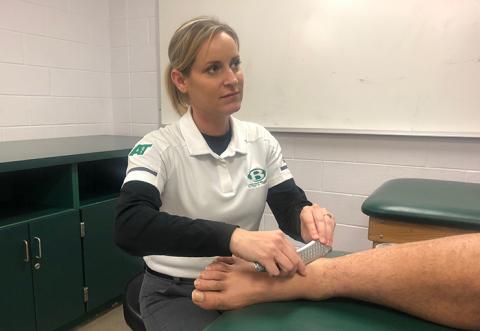
By Jamie Woodall, MPH, LAT, ATC
In the February NATA News, I shared how athletic trainers can own their impact and highlight the value of their role and the profession to their current and potential employers.
Once hired, every choice made, every conversation had, every task completed has been and continues to be a deliberate campaign for the athletic training position and the health and safety of the athlete. Below are a few specific tactics that can be used to show the value of the AT position.
‘Before and After’ Documentation
This includes pictures, stats, ideas, etc. It has been eye opening to look back at the pictures and numbers from the beginning and end of the semester. It is easy to forget the positive impact made every day and not see the progress.
Initial Meeting With the Head Football Coach/AD
Once hired, a meeting was set with the head coach and/or athletic director to discuss many areas that needed to be addressed, understanding that change would have to be a process. Personally, this process hinged on effective communication and positive relationships. Strong, appropriate boundaries are required when wanting to cause change. Several topics that we discussed in this meeting included:
- Requested to present during the beginning-of-the-year head coaches meeting to explain expectations including treatment times, taping, availability (weekends, holidays), etc.
- Explained intentions to communicate with all sports to determine needs including travel kits, treatment times, recovery day workouts, etc.
- Discussion and explanation of specific protocols including weather parameters, emergency drills, coaches compliance and emergency action plans.
Professionalism
As much as this is talked about in athletic training circles, it can’t be stressed enough just how important it is to dress professionally. I dress in business casual during the day, as expected of all staff, and change for practice. If you want to be taken seriously and professionally, then act like it.
Meeting with Stakeholders
Meeting with individuals who have an influence on the athletic training program is key and will help build a support system. A few examples are:
- Meeting with the risk manager to discuss athletic injury trends, mitigating risk and how athletic training services save the district and parents money as well as reducing claims.
- Meeting with local EMS to discuss expectations for when a standby unit is scheduled; certain medical conditions, including heat stroke and C-spine injury of an equipment laden athlete; and general transfer of care, leading to further conversation about athletic training services. A training day can be set up with all EMS to discuss the scope of practice of athletic trainers and how working closely can improve athletic health care.
- Visit area clinics to discuss communication and working together to progress athletes through rehabilitation that have been referred for physical therapy services.
Collected Data from Medical Notes
Collect data from medical notes and contacted doctors to explain what information is needed on participation notes. Contacting medical offices for clarification on medical notes for participation has yielded positive results. All athletes have a release on file that is completed with participation paperwork. This has allowed for improved medical notes. For example, in Texas, a concussion clearance note must be written by a doctor, not a nurse practitioner. For notes that were turned in that were signed by a nurse practitioner, that office was contacted and the explanation was well-received. In addition, the office manager was emailed a fact sheet about the state law regarding concussions. This opened the door to educate more about ATs.
Achieve Compliance Through Education Opportunities
Working with the head AT of the local junior college, students are offered an opportunity to observe in the high school athletic training program. It is important to check with the employer and follow any requirements for volunteers regarding background checks and releases.
Utilize Social Media to Tell Your Story
Announce and highlight updates and accomplishments on social media and capitalize on the message with appropriate mentions and hashtags. Personally, I’ve:
- Promoted the students who participate in cleaning out the stadium athletic training facility used as a storage room for old and outdated equipment.
- Highlighted the individuals who installed potable water on the practice fields.
- Publicly thanked the school district maintenance staff for the multiple work orders that have been submitted and completed for the athletic training program.
In addition, the below strategies can be used to educate parents and stakeholders through social media:
- Use NATA resources and personalize the message with how you implement strategies for prevention and care of athletic injuries.
- Share statistics from atyourownrisk.org to inform parents and athletes about risks and how prevention strategies are implemented by the athletic trainers.
Establish and Communicate Procedures Related to Health And Safety
Each school district usually has a landing spot for important information that can be referenced by staff members. For example, if Google is utilized, a coach's Google Team Drive can be developed that is stocked with resources including athletic EAPs, injury reporting procedures, concussion return-to-play protocol, weather monitoring procedures and parameters, etc.





